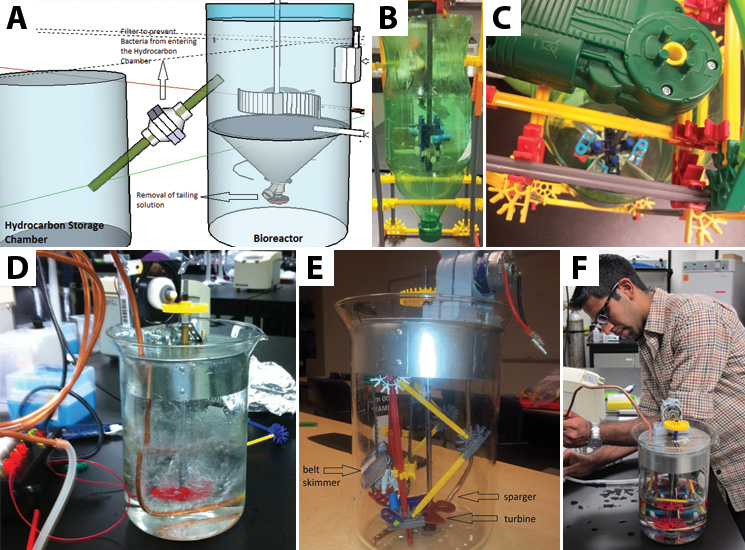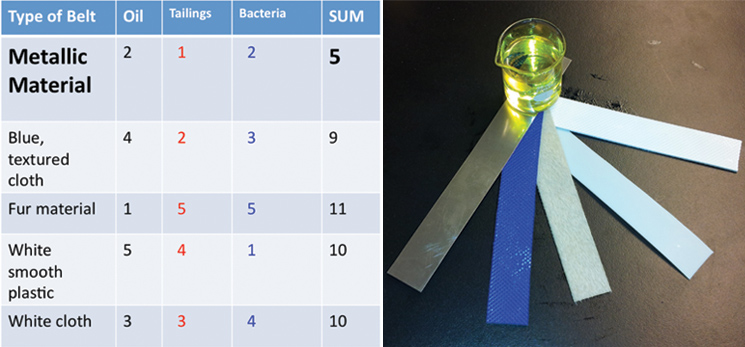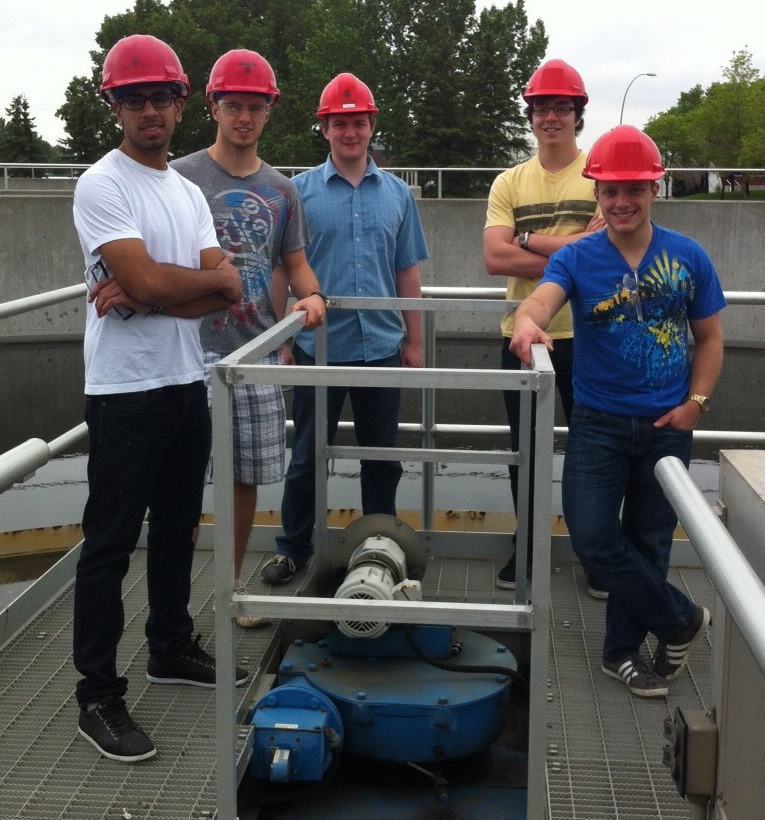Team:Calgary/Project/OSCAR/Bioreactor
From 2012.igem.org
Colinbrown (Talk | contribs) |
|||
| Line 68: | Line 68: | ||
<h2>The Final System</h2> | <h2>The Final System</h2> | ||
| + | Along with physical considerations of the containment unit, we must also consider the composition and growth of the bacteria in the reactor. Each OSCAR would have the most suitable kill-switch circuit attached | ||
| - | <h2> | + | |
| - | <p>The next steps would include developing a feedback and sensing method to monitor the temperature, | + | <h2>Future Directions</h2> |
| + | <p>The next steps would include developing a feedback and sensing method to monitor the temperature, pH, and C02 in a highly toxic and corrosive environment. Once the genetically engineered bacterium is produced we can start modeling the bacterial growth and production cycle. Since we would prefer that our bacteria produce hydrocarbons within their stationary phase, we would like to look into controlling the genetic circuits to become active during this portion of the life-cycle (transcriptional activation coupled to quorum sensing) and possibly into adding bacteria to the bioreactor when it is in its exponential phase rather than the lag phase. This should reduce the time needed for each reactor cycle. Also because we envision OSCAR to be a co-culture of decarboxylation, decatecholizatoin, denitrogenation, and desulfurization, we will want to test the effectiveness of this co-culturing system to produce hydrocarbons and the ability of our prototype to selectively extract them.</p> | ||
</html> | </html> | ||
}} | }} | ||
Revision as of 01:06, 4 October 2012
[http://www.example.com link title]


Hello! iGEM Calgary's wiki functions best with Javascript enabled, especially for mobile devices. We recommend that you enable Javascript on your device for the best wiki-viewing experience. Thanks!
Bioreactor: The House of OSCAR

Introduction
We want to use the genetically engineered bacteria of the OSCAR project to convert toxic organic compounds into recoverable hydrocarbons. To accomplish this goal our team has designed a contained bioreactor system at the scale to operate in the locations of oil sands tailings ponds and oil refineries. We used what is known of similar sized bioreactors and hydrocarbon recovery techniques to decide what factors to consider in the design of OSCAR's home: culture conditions, method for hydrocarbon extraction, and containment of the genetically modified organisms.
Research
Before diving into a making bioreactor, we first had to research current solutions in the field. To help us with this phase, we researched papers on bioreactors that exist with such diverse applications as wastewater treatment, tissue engineering and beer fermentation. To observe a large scale bioreactor, we toured a wastewater treatment plant (we would have preferred a brewery) where we interviewed plant managers and learned conditions that need to considered in big systems: open or closed system (theirs was open), methods for oxygenation and preventing contents from settling. We also interviewed graduate students and professors researching bioreactors at the University of Calgary for their insight as well as meeting weekly with the supervisors and biologists on our team. Below are pictures from our trip to the wastewater plant!
Our Bioreactor Evolution
Throughout the summer we worked on creating a prototype of the bioreactor. The process that was deemed most suitable, was a fed-batch closed system, where the reactors would be continually fed with more bacterial nutrients and fresh tailings in a continuous stir method, which are favored for an industrial scale of (1000+ L tanks). Product is removed at the same rate that biomass and nutrients are added, and tailings are pre-filtered to prevent environmental strains from joining the mix. Additionally, the process would have to occur within an enclosed system to ensure its containment.
Lastly, we needed to pick the best possible process to remove the hydrocarbons from the culture. We decided to use a belt skimmer, similar to those used to help clean up oil spills. This method allows us to run the belt to pick up hydrocarbons without having to remove the entire solution of the batch. This way the bacterial culture already present in the tank can be maintained in active culture to continuously produce more hydrocarbons. To ensure that the belt does not transfer live bacteria into the hydrocarbon tank, will have a UV light aimed at the most apical point in the belt path to ensure that any bacteria picked up by the skimmer receive a lethal dose of light before the hydrocarbons are skimmed from the bioreactor chamber.

The Prototype Design
We determined the essential concepts that needed to be developed in the prototype. As with the scaled up design, we included the belt skimmer, powered by a small motor to move the belt into and out of the system. In the events when we were using live cells, our prototype operated as a completely closed system to prevent cross contamination with microbes outside the chamber.
Once we had these designs in place, we were able to start building models and presentation material. One of our goals was to have a computer animation of our design in motion. We were able to meet this goal by using programs called Maya and RealFlow. Maya is a complex and extremely versatile computer animation program used for many animated movies, including James Cameron’s “Avatar”. RealFlow is a particle-generating program, used primarily for creating fluid flow and fluid effects. Combining both of these programs, we created a seventeen second long video showing the basic idea of how our bioreactor will work. Our model will be brought to the competition for demonstration purposes.
Particle Simulation Using RealFlow2012
Open System Showing Separation of Hydrocarbon Layer
Closed System Showing Emulsified Hydrocarbons
Testing and Results
Using the physical models that we made, we were able to conduct experiments to help determine what will make our design most efficient. We received five different belt samples from a belt skimming company (Abanaki), and conducted three different tests to determine which belt is most suitable for us. Our tests sought to find the belt that picked up the most oil, least tailing pond material, and least amount of bacteria.

Additionally, we ran three different twenty-four hour bacterial growth tests in our tank to determine the effectiveness of the agitator and sparger on bacterial growth. The turbine mixes the solution preventing bacterial cells and other heavier materials from settling at the bottom of the vessel and ensuring even nutrient and reactant distribution in the tank. The sparger aerates the solution, which is necessary for our aerobic bacteria to thrive. When assembled together the turbine is located above the sparger thus breaking each bubble from the sparger into smaller ones. The test was conducted with a turbine and a sparger; a turbine only, and a sparger only. At the end of each experiment we measured the optical density of the solution with a spectrophotometer to quantify the bacterial growth. Operating our bioreactor with both a turbine and sparger resulted in slightly greater bacterial growth than just the turbine, which coincides with our hypothesis. The results are displayed below:

Lastly, we mixed water, commercial NA’s, and hexadecane (model hydrocarbon) together in a small test tube to determine if we will indeed get a top layer of hydrocarbons like what we need. Indeed, this top layer of hydrocarbons was formed after two minutes of time to allow for separation.
Furthermore, we tested our belts ability to pick up hydrocarbons in a solution of water and commercial naphthenic acid. We dipped our belt in a solution of hexadecane, water and naphthenic acid, then removed and scraped the picked up solution into a separate beaker. This sample was then run through GC-MS to analyze the concentration of naphthenic acid found in our skimmed solution. This is an important test for us since we do not want to be removing too many NA's before they have the chance to be converted to hydrocarbons. The results of the GC-MS were very promising. Since we used commercial NA's, there are many different types of NA's in our original solution. To find the concentration of each NA, the number of carbon rings for each type of NA are counted. As can be seen below, the figures show plots of the number of carbon rings of each NA found in the water layer and hydrocarbon layer of our skimmed solution. Based on the size of the bars on the graph, our data shows that a higher abundance of NA were found to be associated with the water and not the hydrocarbon layer. This suggests that minimal NA's were skimmed into our hydrocarbon layer and that most were left in the water layer.
The Final System
Along with physical considerations of the containment unit, we must also consider the composition and growth of the bacteria in the reactor. Each OSCAR would have the most suitable kill-switch circuit attachedFuture Directions
The next steps would include developing a feedback and sensing method to monitor the temperature, pH, and C02 in a highly toxic and corrosive environment. Once the genetically engineered bacterium is produced we can start modeling the bacterial growth and production cycle. Since we would prefer that our bacteria produce hydrocarbons within their stationary phase, we would like to look into controlling the genetic circuits to become active during this portion of the life-cycle (transcriptional activation coupled to quorum sensing) and possibly into adding bacteria to the bioreactor when it is in its exponential phase rather than the lag phase. This should reduce the time needed for each reactor cycle. Also because we envision OSCAR to be a co-culture of decarboxylation, decatecholizatoin, denitrogenation, and desulfurization, we will want to test the effectiveness of this co-culturing system to produce hydrocarbons and the ability of our prototype to selectively extract them.
 "
"
